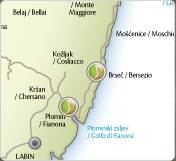
- Sečovlje Salt Pans - Dragonja River Valley
- Sv. Peter - Nova vas - Padna
- Pomjan - Nature Park: Karst Edge - Socerb
- Črni Kal - Osp - Kubed
- Momjan - Grožnjan - Pietrapelosa - Mirna
- Baštija - Kostanjica - Parenzana
- Oprtalj - Završje - Livade - Zrenj
- Istarske toplice - Motovun Forest - Višnjan
- Cave Mramornica - Feštini Kingdom - Cave Baredine
- Lim Bay - Kloštar - Kontija - Dvigrad
- Kanfanar - Bale - Palud - Vodnjan - Brijuni - Fažana
- Svetvinčenat - Tinjan - Pićan - Gračišće
- Belaj - Šumber - Kožljak - Paz
- Čepićko Field - Kršan - Boljun Castle - Lupoglav
- Plomin - Kvarner Gulf - Brseč
- Nature park Učka - Mošćenice
Plomin - Kvarner Gulf - Brseč
Plomin
In the 2nd millennium BC this hill-fort settlement was inhabited by the Liburnians, ancient seafarers and pirates. The arrival of the Romans brings battles for supremacy, so life moves to Plomin Bay. Owing to the great importance of Plomin, Roman Flanona, Kvarner acquires the name Sinus Flanaticus. Under the Roman influence, the population of that area, as well as entire Istria, accepts Roman deities, and...
Больше

Kvarner gulf
This exotic combination of the Mediterranean and mountains is situated in the northern Adriatic, between the Istrian Peninsula and northern Croatian littoral. Here, the sea depth is considerably greater than in the upper Adriatic, which is filled up with abundant silt of the Po River and other Italian rivers, making it more navigable.
The significance of Kvarner as a region connecting the Mediterranean and...
Больше
Brseč
Perched on a steep rock, 157 meters above sea level, this medieval town offers a spectacular view. But, such is the view of this town as well. The town has a view of the islands Cres, Unije, Susak and Mount Učka. The very first traces of living date from prehistoric times, whereas Brseč was first mentioned in written sources in the 11th c. The ring of the Liburnian hill-fort is visible in today's layout of Brseč, it...
Больше
 Напечатай страницу Отправь другу
Напечатай страницу Отправь другу















